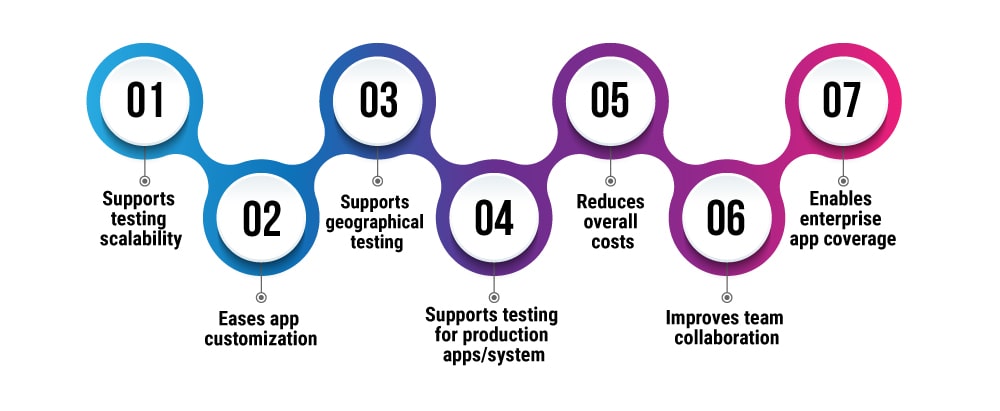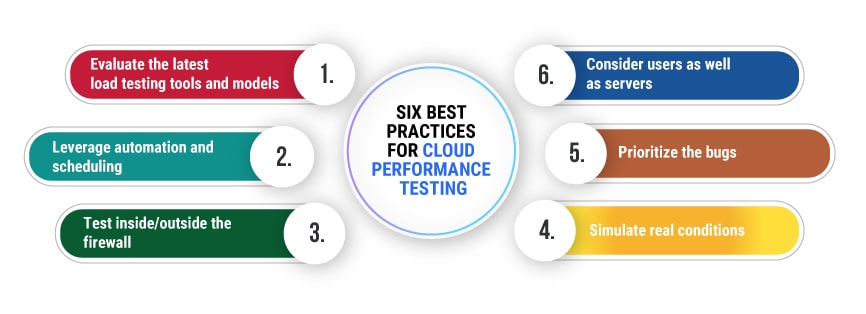Published: 25 Oct 2022
6 Best Practices for Cloud Performance Testing
Last Updated: 01 Dec 2023
Content
1. An overview of cloud performance testing
2. What needs to be Tested?
3. Cloud Performance Testing or Inhouse Testing?
4. Seven business benefits of cloud performance testing
5. Types of cloud performance testing
6. Six best practices for cloud performance testing
7. Key cloud performance testing metrics
8. Top cloud performance testing tools
9. Conclusion
10. How can Tx help?
An overview of cloud performance testing

Today, digital businesses race to launch high-quality applications as early as possible, and time to market plays an important role in determining the application’s success. However, without effective testing, the final product could be futile. There is always a need for tools and techniques that accelerate the development and testing process.
Performance testing simulates heavy loads and assesses the performance of apps and infrastructure to ensure that downtime doesn’t derail a business’s cashflows, promotions, and peak business times.
But on-premise testing comes at a price, takes significant time, needs dedicated infrastructure and has certain limitations. This is where cloud performance testing proves to be a wise business decision. Cloud performance testing is comparatively inexpensive and may be used for testing cloud, web, and installed applications. It uses cloud-based tools to emulate real-world traffic and helps businesses measure their apps’ performance, scalability, security, and reliability.
What needs to be Tested?
Cloud performance testing centers around evaluating three fundamental aspects:
Swiftness – Verifying the application’s responsiveness and promptness.
Expandability – Assessing the upper threshold of user load the application can manage.
Reliability – Ensuring the application’s stability across diverse load conditions.
Fundamentally, the objective of performance testing is not the discovery of defects or bugs, but rather the eradication of potential performance bottlenecks that could arise within an application. It’s occasionally denoted as “Perf Testing,” constituting a subset of the broader domain of performance engineering.
Cloud Performance Testing or Inhouse Testing?
In the past, conventional in-house performance testing constituted a resource-intensive undertaking and placed a strain on IT departments. It necessitated intricate infrastructure and substantial resources that were frequently utilized only intermittently.
As business paradigms evolve and operational frameworks extend beyond physical office spaces, maintaining in-house testing facilities is growing increasingly challenging for organizations. Cloud-based testing tools deviate from conventional in-house applications. Performance testing in the cloud assesses metrics such as the system’s throughput and latency in response to varying numbers of concurrent users accessing the application. Additionally, it gauges diverse load profiles and an array of performance parameters.
Elasticity stands as a pivotal attribute within cloud infrastructure, encapsulating the cloud’s capacity to effectively manage fluctuations in load by augmenting resources during peak demands or rationalizing user distribution when loads diminish. This dynamic adjustment takes place seamlessly within an operational cloud environment.
Scalability, availability, fault tolerance, and reliability constitute additional components that contribute to an ideal cloud infrastructure.
Moreover, cloud-based load testing offers the opportunity to attain peak performance through a cost-efficient approach to testing applications at an expansive scale. This is achieved by simulating load tests encompassing millions of concurrent users originating from diverse geographical locations.
Seven business benefits of cloud performance testing

Cloud performance testing ensures the application runs as intended in a cloud environment with optimum infrastructure and offers the desired user experience. Knowing that the application is at par with the performance standards, digital businesses can focus on scalability, flexibility, and reduced overhead for research and development. Here are the seven key advantages of cloud performance testing:
Supports testing scalability:
While leveraging a cloud-based testing platform, digital businesses do not have to limit the number of users for performance testing. Cloud performance testing is more realistic regarding visits from an expected number of users and from different geo locations just like peak business hours or holiday seasons.
Eases app customization:
Using a cloud system to test applications is advantageous for organizations because they can use it to emulate customer-centric environments. Cloud testing enables the utilization of various permutations of test scenarios that include different configurations, web browsers, OS, and more. As a result, businesses can make the necessary customizations to save costs and time in procuring different devices at different locations.
Supports geographical testing:
Cloud performance testing may be executed from anywhere. In other words, businesses can test their apps globally wherever the app will be available, hence enabling global scalability.
Supports testing for production apps/system:
Application tests are generally limited to their test environment, but it is possible to execute cloud performance testing in production environments.
Reduces overall costs:
Using the cloud as a testing platform reduces the need for installation and maintenance configuration, reducing overall costs.
Improves team collaboration:
Cloud-based testing allows software companies to include DevOps in their workflows because it requires collaboration between developers and testers. Testers can spin up test environments with different configurations and data in the cloud, automate testing processes, integrate with development tools to provide fast feedback and get DevOps to help set up devices.
Enables enterprise app coverage:
While most applications today are browser-based, large enterprise apps require relatively higher computing capabilities. Cloud-based testing enables effective testing with support for various internet protocols, .NET, Java, SAP, Siebel, and other enterprise application protocols to validate web 2.0 applications like AJAX, Silverlight, and Flex.
Types of cloud performance testing

Load test – performed to measure the performance of the application under normal and peak conditions
Failover test – performed to validate the app’s ability to provide extra resources and engage a backup system during system failure
Capacity/volume test – performed to measure the number of users the app can handle before experiencing any issues
Soak test – performed to measure the performance of the application under extreme loads for an extended period
Stress test – performed to measure the performance of the app when exposed to conditions outside of the scope of regular operations
Browser test – validates that the application works as intended when accessed through different web browsers
Targeted infrastructure test – isolates and measures each layer and/or component of the application to test its performance
Latency test – measures the amount of time it takes to move a data packet from one point to another within the network
Six best practices for cloud performance testing

Evaluate the latest load testing tools and models:
Some of the available load-generating apps work across cloud platforms but verifying the compatibility of such tools with the application architecture is essential. Key features such as bandwidth simulation, upload/download speeds, etc., should be accurately represented to understand the load limits.
Leverage automation and scheduling:
Choose the load testing tools that include features such as analytics, reports, and scheduling. This helps DevOps teams avoid overworking production systems while testing and scheduling the ongoing load tests. Once the tests are completed, these tools share comprehensive reports with the respective stakeholders so that everyone has a clear picture of how the app is performing.
Test inside/outside the firewall:
In case of several possible reasons for poor app performance, it is difficult to identify the root cause. The load test plan should include testing both inside and outside the firewall to find and fix the performance bottlenecks.
Simulate real conditions:
Merely exposing the app to high loads until failure may not generate a realistic scenario. Similar is the case with using similar types of devices, browsers, bandwidths, or OS. The load testing environment should be able to provide a diverse range of test scenarios, keeping the user load at a base level with different configurations.
Prioritize the bugs:
To maximize the value of cloud performance testing, teams must prioritize the bugs. Once the data and insights are available, teams should strategically take necessary actions to achieve the maximum ROI from testing efforts.
Consider users as well as servers:
Performance tests are often focused on servers and clusters. However, these tests should measure the human element as well. Cloud performance testing should consider UX for comprehensive test results.
Key cloud performance testing metrics

Cloud performance testing varies from the traditional types of application testing. The main aim of cloud performance testing is to measure the key performance parameters. The following are the critical performance testing metrics digital businesses must consider:
CPU utilization:
The percentage of CPU capacity utilized in processing the requests.
Memory utilization:
Measures the utilization of the computer’s primary memory while processing any work requests.
Response times:
The total time between sending and receiving the request. Better the response time, the better the performance of the application.
Average load time:
This metric determines the time a webpage takes to load and display the content on the screen.
Throughput:
This metric determines the number of transactions an application can handle per second.
Average latency/Wait time:
The time spent by request in a queue before processing.
Bandwidth:
It measures the data volume transferred every second.
Requests per second:
This metric measures the number of requests the app handles every second.
Error rate:
It measures the percentage of requests leading to errors compared to the total number of requests.
Transactions Passed/Failed:
The percentage of passed/failed transactions against the total number of transactions.
Top cloud performance testing tools

Tricentis NeoLoad:
Provides automatic test design and maintenance, simulation of user behavior, fast root cause analysis, and built-in integrations with the entire software development lifecycle toolchain.
CloudTest:
Enables continuous testing process in the cloud without worrying about any hardware.
BlazeMeter:
Facilitates the desired number of users, user behavior, and duration through custom-built load and stress testing scenarios.
AppPerfect:
Helps to design and simulate thousands of users to load test applications for performance, reliability, and scalability.
Azure Load Test:
Used to run URL-based load tests with Azure DevOps and sets all the required parameters to run the test.
SmartBear LoadNinja:
Produces intelligent and accurate data that helps analyze the performance of websites, web applications, and APIs in real-time using accurate browser-based metrics.
LoadView:
Uses the Google Cloud Platform (GCP) and Amazon Web Services (AWS) to generate concurrent user load over the cloud during the load tests.
Conclusion
Performance testing is essential to the app’s success in DevOps processes. A high-performing app is critical for businesses to yield the expected ROI while enabling a great CX to the end users. By leveraging the cloud for performance testing, digital businesses can achieve high-performing and scalable apps without blowing out on costs and timelines. Thus, enterprises should leverage cloud performance testing from a next-gen QA and independent software testing services provider for high-performing apps and faster time to market.
How can Tx help?

TestingXperts (Tx) is a leading performance and load testing service provider for businesses across domains. Leverage next-gen testing services provider for your solutions’ end-to-end digital and performance testing to deliver a seamless user experience.
• Predict application behavior and benchmark application performance
• Ensure your application is responsive, reliable, robust, and scalable
• Ensure your application meets all contractual obligations and SLAs for performance
• Comprehensive performance & load testing services across domains and technologies
• Detailed reporting with response times, breakpoints, peak load, memory leaks, resource utilization, uptime, etc.
• Get in touch with our performance testing experts to know more.